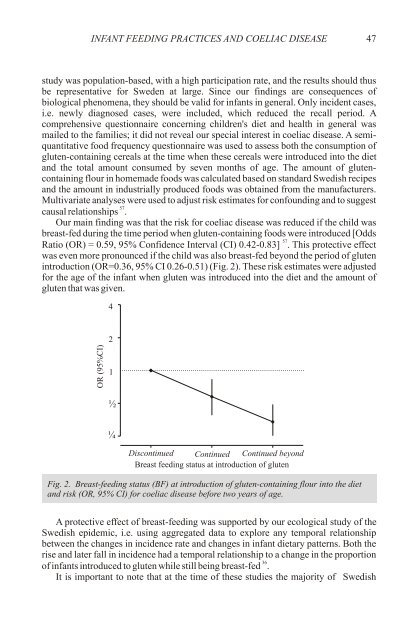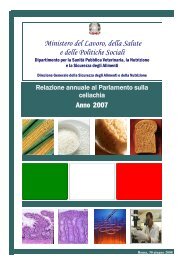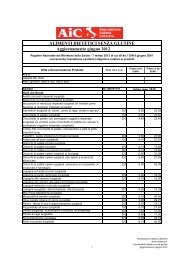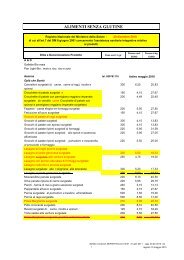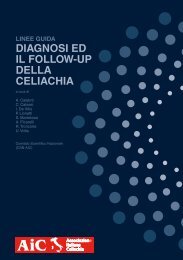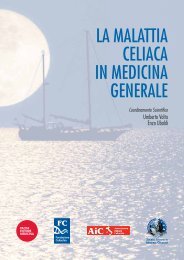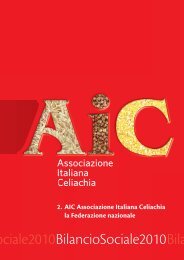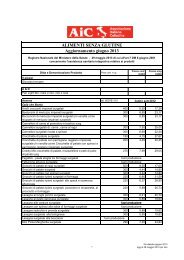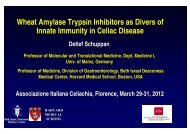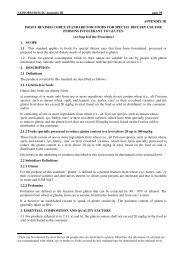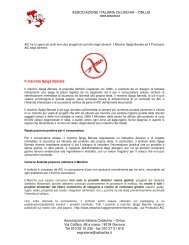primary prevention of coeliac disease - Associazione Italiana ...
primary prevention of coeliac disease - Associazione Italiana ...
primary prevention of coeliac disease - Associazione Italiana ...
Create successful ePaper yourself
Turn your PDF publications into a flip-book with our unique Google optimized e-Paper software.
OR (95%CI)<br />
INFANT FEEDING PRACTICES AND COELIAC DISEASE<br />
47<br />
study was population-based, with a high participation rate, and the results should thus<br />
be representative for Sweden at large. Since our findings are consequences <strong>of</strong><br />
biological phenomena, they should be valid for infants in general. Only incident cases,<br />
i.e. newly diagnosed cases, were included, which reduced the recall period. A<br />
comprehensive questionnaire concerning children's diet and health in general was<br />
mailed to the families; it did not reveal our special interest in <strong>coeliac</strong> <strong>disease</strong>. A semiquantitative<br />
food frequency questionnaire was used to assess both the consumption <strong>of</strong><br />
gluten-containing cereals at the time when these cereals were introduced into the diet<br />
and the total amount consumed by seven months <strong>of</strong> age. The amount <strong>of</strong> glutencontaining<br />
flour in homemade foods was calculated based on standard Swedish recipes<br />
and the amount in industrially produced foods was obtained from the manufacturers.<br />
Multivariate analyses were used to adjust risk estimates for confounding and to suggest<br />
57<br />
causal relationships .<br />
Our main finding was that the risk for <strong>coeliac</strong> <strong>disease</strong> was reduced if the child was<br />
breast-fed during the time period when gluten-containing foods were introduced [Odds<br />
57<br />
Ratio (OR) = 0.59, 95% Confidence Interval (CI) 0.42-0.83] . This protective effect<br />
was even more pronounced if the child was also breast-fed beyond the period <strong>of</strong> gluten<br />
introduction (OR=0.36, 95% CI 0.26-0.51) (Fig. 2). These risk estimates were adjusted<br />
for the age <strong>of</strong> the infant when gluten was introduced into the diet and the amount <strong>of</strong><br />
gluten that was given.<br />
4<br />
2<br />
1<br />
½<br />
¼<br />
Discontinued Continued Continued beyond<br />
Breast feeding status at introduction <strong>of</strong> gluten<br />
Fig. 2. Breast-feeding status (BF) at introduction <strong>of</strong> gluten-containing flour into the diet<br />
and risk (OR, 95% CI) for <strong>coeliac</strong> <strong>disease</strong> before two years <strong>of</strong> age.<br />
A protective effect <strong>of</strong> breast-feeding was supported by our ecological study <strong>of</strong> the<br />
Swedish epidemic, i.e. using aggregated data to explore any temporal relationship<br />
between the changes in incidence rate and changes in infant dietary patterns. Both the<br />
rise and later fall in incidence had a temporal relationship to a change in the proportion<br />
36<br />
<strong>of</strong> infants introduced to gluten while still being breast-fed .<br />
It is important to note that at the time <strong>of</strong> these studies the majority <strong>of</strong> Swedish


